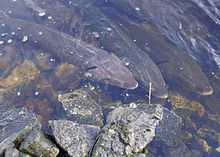Sea sturgeon
| Sea sturgeon | ||||||||||||
|---|---|---|---|---|---|---|---|---|---|---|---|---|

Sea sturgeon ( Acipenser fulvescens ) |
||||||||||||
| Systematics | ||||||||||||
|
||||||||||||
| Scientific name | ||||||||||||
| Acipenser fulvescens | ||||||||||||
| Rafinesque , 1817 |
The lake sturgeon ( Acipenser fulvescens ) is a species from the genus of sturgeon ( Acipenser ), which in North America is found in rivers and lakes. It is fished commercially and by sport fishermen.
features
The sea sturgeon has the typical elongated body structure of the sturgeon. The snout has four smooth barbels and is pointed in young animals, but becomes more and more blunt and wider with age. Five rows of bone plates run along the body, one along the back, one midway along the flank and one along the edge of the abdomen. In young animals, the plates are large and formed into sharply pointed hooks, the skin is rough. With increasing age, the scales become dull and shrink until they almost completely disappear, the skin becomes smoother. The first plate of the back row touches the head plate. The back row has 9 to 15 plates, the side rows 29 to 42 and the ventral rows 7 to 12. One or two bone plates are also found behind the dorsal and anal fin, but neither are flanked by bone plates. Young animals are reddish-brown and have irregular black spots. Adults are greenish-olive-brown or grayish without markings. The dorsal fin has 35 to 45, the anal fin 25 to 30 soft rays. The arches of the gill trap carry 25 to 40 rays. Adult animals reach an average length of one to 1.80 meters and a maximum of 2.7 meters and a weight of up to 125 kg. The maximum age should be up to 152 years.
Occurrence
The lake sturgeon occurs in the Saint Lawrence River , the Great Lakes , Lake Champlain , Hudson Bay , the Saskatchewan River, and the Mississippi River system to northern Louisiana and southern South Dakota . There is likely no exchange between the stocks in the Great Lakes and Western Canada and those of the Mississippi.
Way of life
The species lives on the bottom of lakes and large rivers. Occasionally it penetrates brackish water , but not salt water. Food is tracked down at the bottom with the help of barbels. Sea sturgeon are not very picky omnivores that eat insects , mollusks , fish and worms, among other things . Some hikes of more than 1000 kilometers are undertaken between different feeding and spawning grounds.
The mating season begins in spring when the water temperature reaches 9 to 15 ° C. While the males reproduce every two to four years, the females only spawn every three to seven years. The up to 7,000,000 eggs per female are laid in the stony banks of lakes and rivers. Sexual maturity is reached by males at the age of 14 to 16 years and about 114 cm in length, by females only at 24 to 26 years of age and 140 cm in length.
Use and endangerment
While fishing for sea sturgeon for commercial purposes is prohibited in the US , the species is fished in Canada for its meat and caviar . Sport fishing is permitted in some US states at certain times. Due to the long generation times, the species is prone to failure. In the Washington Convention on the Protection of Species , the sea sturgeon is listed in Appendix II, the IUCN currently assesses the population as not endangered (Least Concern).
The sea sturgeon is parasitized by the Namao virus .
Web links
swell
- ^ Minister of Supply and Services Canada: CITES Identification Guide - Sturgeons and Paddlefish: Guide to the Identification of Sturgeon and Paddlefish Species Controlled under the Convention on International Trade in Endangered Species of Wild Fauna and Flora . Wildlife Enforcement and Intelligence Division, Environment Canada, 2001, ISBN 0-660-61641-6 (English, French, Spanish, full text [PDF]).
- ↑ a b See-Sturgeon on Fishbase.org (English)
- ^ Samuel Eddy, James Campbell Underhill: Northern fishes; with special reference to the Upper Mississippi Valley . 3. Edition. University of Minnesota Press, 1974, ISBN 978-0-8166-0674-0 , pp. 126-127 .
- ↑ a b c Entry in the IUCN Red List
